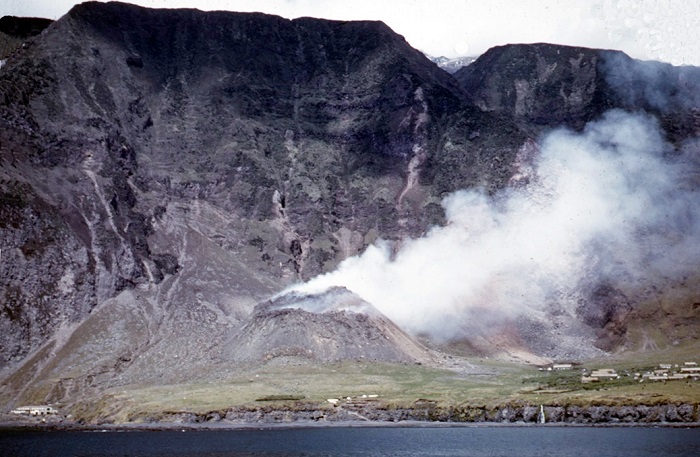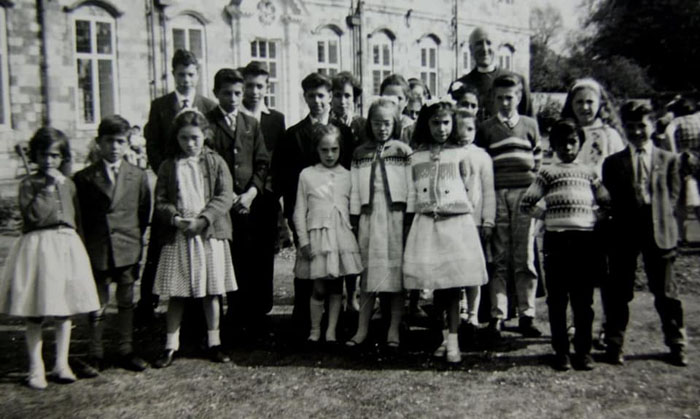Remembering the 1961 Volcano
By Rachel Green. Interviews recorded by Randal Repetto
 This year in 2021, we commemorate the 60th Anniversary of the 1961 Volcano. A very frightening and traumatic time for the islanders of Tristan da Cunha, when they had to leave the only place they knew behind and move to the 'outside world'.
This year in 2021, we commemorate the 60th Anniversary of the 1961 Volcano. A very frightening and traumatic time for the islanders of Tristan da Cunha, when they had to leave the only place they knew behind and move to the 'outside world'.
The islanders who can still remember the traumatic experience still tell their stories today, as it was an experience that changed their lives forever.
|
Lars Repetto [mp3 - 2m 48s] |
The new volcanic cone looms above island houses |
|
Gladys Lavarello [mp3 - 8m 12s] |
|
|
Eric Glass [mp3 - 1m 25s] |
|
|
Ches Lavarello [mp3 - 0m 29s] |
|
|
Harold Green [mp3 - 1m 21s] |
It all started during August and September 1961 as earth tremors became frequent and caused many landslides behind the settlement. On the 8th of October a large tremor and landslide particularly affected the eastern settlement. Families had to move overnight to the homes of relatives in the western side of the village. The following morning saw a fissure open between the settlement and the canning factory where the ground rose. At a hastily organised meeting in the community hall, convened by Administrator Peter Wheeler, it was agreed to evacuate all the 264 islanders and 31 expatriates to huts at the Potato Patches. By the 10th of October the rising ground had become a new volcanic cone and threatened the settlement nearby.

The growing volcanic cone on 13th October 1961 before lava started to flow, photographed from HMS Leopard.
A thick layer of lava eventually buried the factory (bottom left), but the settlement (right) was mercifully spared.
A decision was taken to evacuate the island. Luck was on the community's side as ships were immediately available for the three stage relay journey which projected the world's most isolated community from their quiet home village into the glare of world publicity. The fishing boats Tristania and Frances Repetto were on hand to take the islanders out of immediate danger to Nightingale Island to shelter overnight. The following day, 11th October, the Dutch ship Tjisadane, picked up the marooned islanders for the leg to Cape Town. After a few days the islander boarded the RMS Stirling Castle to arrive in Southampton on the 3rd of November 1961.

Evacuee Tristanian children pictured in England
| When the Stirling Castle docked, they were not only met by officials and the volunteers who would help them adapt to life in England, but also by a large crowd of reporters and film crews. | |
| The radio journalist René Cutforth interviewed some of the islanders shortly after they arrived, mostly about life before the volcano and their thoughts about the future. However, Basil Lavarello, who was 30 years old at the time, talked through everything that happened, from the first tremors to departure on the Tjisadane, while Mary Swain (65) gave a vivid account of her own experiences during the evacuation. Scottie, who she mentions, was the captain of the Tristania. Granny Mary, who was the island's midwife, was popular with the press because she had a way with words and always had something to say. |
Basil Lavarello in 1961 [mp3 - 9m 12s] Mary Swain in 1961 [mp3 - 6m 37s] |
| Obviously, the islanders eventually returned home to Tristan, but we will save saying more about their time in England and the resettlement until a later date. | |

